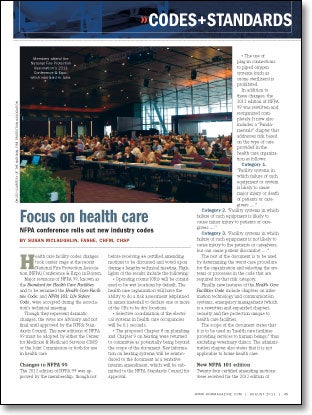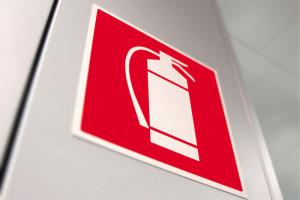Focus on health care
 Health care facility codes changes took center stage at the recent National Fire Protection Association (NFPA) Conference & Expo in Boston.
Health care facility codes changes took center stage at the recent National Fire Protection Association (NFPA) Conference & Expo in Boston.
Major revisions of NFPA 99, known as the Standard for Health Care Facilities and to be renamed the Health Care Facilities Code; and NFPA 101: Life Safety Code, were accepted during the association's technical meeting.
Though they represent dramatic changes, the votes are advisory and not final until approved by the NFPA Standards Council. The new editions of NFPA 99 must be adopted by either the Center for Medicare & Medicaid Services (CMS) or the Joint Commission or both for use in health care.
Changes to NFPA 99
The 2012 edition of NFPA 99 was approved by the membership, though not before receiving 44 certified amending motions to be discussed and voted upon during a lengthy technical meeting. Highlights of the results include the following:
• Operating rooms (ORs) will be considered to be wet locations by default. The health care organization will have the ability to do a risk assessment (explained in annex material) to declare one or more of the ORs to be dry locations.
• Selective coordination of the electrical systems in health care occupancies will be 0.1 seconds.
• The proposed Chapter 8 on plumbing and Chapter 9 on heating were returned to committee as potentially being beyond the scope of the document. Key information on heating systems will be reintroduced to the document as a tentative interim amendment, which will be submitted to the NFPA Standards Council for approval.
• The use of plug-in connections to piped oxygen systems (such as ozone sterilizers) is prohibited.
In addition to these changes, the 2012 edition of NFPA 99 was rewritten and reorganized completely. It now also includes a "Fundamentals" chapter that addresses risk based on the type of care provided in the health care organization as follows:
Category 1. "Facility systems in which failure of such equipment or system is likely to cause major injury or death of patients or caregivers ... ."
Category 2. "Facility systems in which failure of such equipment is likely to cause minor injury to patients or caregivers ... ."
Category 3. "Facility systems in which failure of such equipment is not likely to cause injury to the patients or caregivers, but can cause patient discomfort ... ."
The rest of the document is to be used by determining the worst-case procedure for the organization and selecting the systems or processes in the code that are required for that risk category.
Finally, new features of the Health Care Facilities Code include chapters on information technology and communication systems, emergency management (which is a rewritten and expanded chapter), security and fire protection unique to health care facilities.
The scope of the document states that it is to be used in "health care facilities providing services to human beings," thus excluding veterinary clinics. The administration chapter also states that it is not applicable to home health care.
New NFPA 101 edition
Twenty-four certified amending motions were received for the 2012 edition of NFPA 101, the Life Safety Code, which also was approved by the assembly. Significant votes include the following:
• A motion to remove the requirement for smoke barriers on a floor below a health care occupancy was defeated.
• Starting with the 2009 edition of the Life Safety Code, special locking arrangements were permitted due to safety and clinical needs based on 19.2.2.2.5.1(2) and 19.2.2.2.5.2. However, there are requirements to do so in both new and existing health care occupancies that would require the areas to be sprinklered. A motion was made to remove the retroactive sprinklering requirement for special locking arrangements in existing health care areas, but that motion was also defeated.
Measures for health care occupancies that are included in the 2012 Life Safety Code include the following:
• In areas with nine or fewer individuals, sliding doors no longer need a break-away feature, but corridor doors still need latching and smoke resistance.
• One container of alcohol-based hand gel in each room may be exempted from the total quantity in a smoke compartment.
• Above handrail height, 6-inch corridor projections of any type are acceptable.
• The section on suites has been reorganized, with the size of new sleeping suites at 7,500 square feet, or 10,000 square feet if there is direct visual supervision and the space is fully and automatically smoke detected.
• Patient room closets of less than 6 square feet do not need to be sprinklered.
• Larger recycling and linen containers will be permitted, up to 96 gallons in capacity, without being placed in an area protected as hazardous.
• Certain additional items will be permitted to be stored in corridors, as long as 5 feet of clear width remains and there is a fire plan to remove the equipment.
Finally, the 2012 edition of the Life Safety Code contains some cultural change provisions that are intended to improve nursing home design and move it to more of a homelike setting.
With certain provisions, for instance, some seating will be allowed in an 8-foot corridor, and certain cooking facilities will be permitted to be open to the corridor. Gas fireplaces will be permitted in fully sprinklered sleeping compartments. However, there are many requirements and restrictions on these issues and the full text of the 2012 edition should be consulted for details once it is published.
Again, these changes are not in effect until the 2012 edition of the Life Safety Code is adopted by either CMS or the Joint Commission or both.
Other codes issues
The 2012 edition of NFPA 1: Fire Code, received no certified amending motions, and was accepted as a consent document.
If the document is adopted by an authority having jurisdiction (AHJ), a health care organization will be impacted by several items, including the following:
- Medical gas is now included within the scope of this document.
- Elevators will require standard fire-service keys, or multiple-elevator keys must be kept accessible to the fire department, such as in a lockbox.
- Minimum fire department radio signals must be maintained in both new and existing buildings.
- Those who perform visual inspection of fire-resistant construction in high-rise buildings must have knowledge and experience that is acceptable to the AHJ.
Additionally, the Healthcare Interpretations Task Force (HITF) met during the conference to address the following:
- Acceptable exits from sleeping suites.
- Fire- and smoke-resistance issues relating to pass-through, nurse-server cabinets.
- Locks on patient room doors.
- Murals to disguise doors for clinical needs, such as Alzheimer's or dementia units.
- Alcohol-based hand sanitizer placement in relation to sources of ignition, such as light switches and electrical outlets.
- The five-year standpipe flow test applicability to manual systems.
The HITF membership comprises AHJs and other organizations that impact health care fire protection. They include the NFPA, Agency for Health Care Administration, American Health Care Association, American Society for Healthcare Engineering (ASHE), Centers for Medicare & Medicaid Services, Department of Defense, Indian Health Service, International Fire Marshals Association, Joint Commission and Department of Veterans Affairs.
The outcomes of these discussions will be posted on the ASHE and NFPA websites once decisions have been finalized.
Adoptions of 99 and 101
During an educational session, a representative from CMS indicated that the Centers will examine the new editions of both NFPA 99 and NFPA 101 for potential adoption. However, even if these documents are reviewed favorably, it still will take approximately 30 months for the conditions of participation to be changed through the federal regulation process, which will include acceptance of public comments.
Additionally, a Joint Commission representative stated that it will follow suit once CMS adopts a more current code edition. The Joint Commission is waiting for CMS action because costly compliance dilemmas are created when both organizations use different code editions.
To learn more about decisions made during the conference voting sessions, actions on NFPA 99 can be accessed online at
http://nfpa.typepad.com/conference/2011/06/action-on-nfpa-99-standard-for-health-care-facilities.html and actions on NFPA 101 can be found by logging on to http://nfpa.typepad.com/conference/2011/06/action-on-nfpa-101-life-safety-code.html.
Susan B. McLaughlin, FASHE, CHFM, CHSP, is managing director of MSL Healthcare Consulting Inc., Barrington, Ill., and a former associate director of standards interpretation at the Joint Commission. She can be reached atsmclaughlin@mslhealthcare.com.
| Sidebar - Beyond the codes issues |
| In addition to codes adoption issues, the recent National Fire Protection Association (NFPA) Conference & Expo in Boston provided a variety of educational programs, networking opportunities and a large trade show featuring products and services in the areas of fire protection, fire safety, emergency management and related disciplines. The NFPA Health Care Section sponsored three educational programs during the conference, including a summary of proposed changes to the 2012 edition of NFPA 99, and a presentation on changes in NFPA 101 between the currently adopted 2000 edition and the 2012 proposed document. Additionally, officials from the Joint Commission and Centers for Medicare & Medicaid Services participated in a session on "Health Care Hot Topics and Authorities Having Jurisdiction (AHJs) Interpretations." Following a presentation of updates from each agency, the audience had an opportunity to participate in a question-and-answer session with the AHJs. New officers of the Health Care Section executive board are Dean Menken, immediate past chairman; Phil Thomas, chairman; David Hood, first vice chairman; Jeff Combs, second vice chairman; and Chris Mallett, secretary. In addition, Mitchell Elliott was nominated to fill the unexpired board position vacated by Chris Mallett. The 2012 NFPA Conference and Expo will be held in Las Vegas in June. Health facility professionals are encouraged to attend. |




